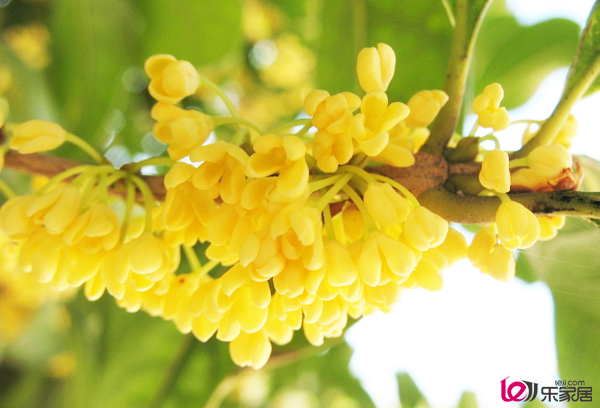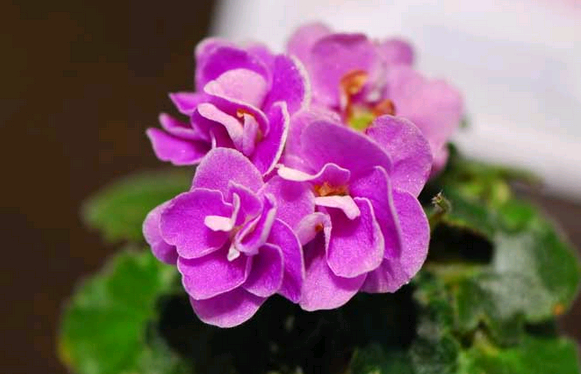How to raise potted violets
How to raise potted violets? Pot violets should choose dwarf varieties. After sowing and emergence, the seedlings were planted with long oval cotyledons, light green cotyledons, wavy edges of true leaves, large and obvious defects. The reoperation rate of this kind of seedling is high, and the price of cut flowers is much higher than that of individual plants.
Violet taproot plant, the whisker root is underdeveloped, when raising seedlings, it is best to transplant the true leaves before spreading, and bring more persistent soil, in order to survive. The "crystal" shape of every 3 plants should be planted in a large basin with a diameter of 25 cm, and then put in the room at low temperature. 20 days after planting, a coring was carried out when the leaves grew to 10 leaves, which promoted the branching. Watering should not be frequent, potted violets can be watered every 3 days. Greenhouse cultivation often adjusts indoor temperature and humidity through ventilation.

Selection of potted Violet varieties
Potted violets should choose double petal varieties with short planting. Seedlings with light leaves, oval shape and wavy shape should be selected at the seedling stage.
Potted violets are suitable for flowerpots
The pot diameter of potted violets should choose a large pot about 25cm is the most suitable. The disinfected loose and fertile soil should be selected for cultivation, and the base fertilizer should be applied in the basin, and 3 plants can be planted in each basin.
How to choose Violet Culture soil
Violet likes loose, fertile acidic soil. When potted, the culture soil made of rotten leaf soil, peat soil and sandy soil can be used.
The light of violets should be suitable.
Violet likes a semi-overcast environment. However, too much shade will lead to too little or no flowering of violets; if the light is too strong, it will cause the leaves to yellowing and make the plants dry and damaged.
The temperature of violets should be suitable.
The suitable temperature for violet growth is 18 ℃-24 ℃. When the temperature exceeds 27 ℃, it will lead to poor growth and lack of water. The temperature will be lower than 12 ℃ at the end of autumn and the beginning of winter, so pot violets should be moved indoors for breeding, otherwise they will be frostbitten.
Proper watering of violets
The violets should be watered thoroughly and placed in a cool, dark place. After 3-4 days, they can be placed in a well-ventilated sunny place. Of course, do not water too much, otherwise it will cause rotten roots. At the same time, we should be careful not to splash on the leaves, otherwise it will cause the leaves to rot.
The fertilization of potted violets should be light.
During the growth and development period of Violet, a thin rotten liquid fertilizer or compound fertilizer is applied once every 7-10 days. The application of nitrogen fertilizer should not be too much, and the ratio of nitrogen, phosphorus and potassium should be 1:1:1. If more phosphorus and potassium fertilizer is applied after the emergence of flower buds, the flowers will be large and colorful.
Coring and seed collection of potted violets
When it rises to about 9 leaves, it needs to be coring to promote branching. The plant grows to 40cm and needs to be supported by a thin bamboo pole.
As a reserved seed, the seeds should be harvested in time before the pods turn yellow and do not crack.
How to raise potted violets?
Violet, also known as sweet-scented osmanthus and Sitaoke, is a biennial or perennial herb of Cruciferae. It has luxuriant flowers, bright colors, rich aroma, long flowering period and long inflorescence. It is loved by many flower lovers and is suitable for potted plants. Let's take a look at how potted violets are cultivated.
The growth habit of Violet
Violet likes cool climate, avoid dry and hot, like well-ventilated environment, mild climate in winter, but can also withstand short-5 ℃ low temperature. The suitable temperature for growth is about 15: 18 ℃ in daytime and 10 ℃ at night. It is not strict with soil, but it grows well in soil with good drainage and neutral alkali, and avoids acidic soil. Resistant to cold and shade, afraid of waterlogging, suitable for growing in a higher position, and vulnerable to diseases and insect pests in hot and mildew weather and poor ventilation, fertilization should not be too much, otherwise it is disadvantageous to flowering, and it is easy to suffer from diseases and insect pests if the light and ventilation are not sufficient.
Propagation methods of Violet
1. Cutting: Violet cutting propagation is mostly carried out from April to June every year, fine sand can be used as propagation substrate, and the cutting survival rate is very high, which can reach more than 95%. Stem tips with a length of 6 cm to 8 cm are usually used as propagation material, and their groups are inserted into flowerpots with fine sand, with a depth of about 1 cm. After cutting every day spray water moisturizing, about a month or so, cuttings can grow luxuriant roots, at this time can be planted separately.
2. Sowing: violets usually take a year as a growth cycle, sowing and propagation can be carried out twice in a year, sowing in spring or sowing at the end of summer every year. No matter sowing in spring or sowing at the end of summer, there should be fertile and moist soil, and the soil should be wet by soaking after sowing, and the temperature should be kept at 15: 20 ℃ and germinate and sprout after 10 ~ 15 days.
How to raise potted violets?
1. Soil: violets do not have strict requirements on soil, but grow better in soils with good drainage and neutral alkali, and avoid acidic soil. 2 parts of humus soil, 2 parts of garden soil and 1 part of river sand can be mixed in basin soil.
2. Watering: Violet should be watered immediately when it is dry and white on the surface of the soil, and dry when it is wet.
3. Sunshine: violets like to have plenty of sunshine, but they are also slightly resistant to semi-shade. If the light and ventilation are not adequate, they are prone to diseases and insect pests.
Temperature: Violet likes the environment with warm winter, cool summer and good ventilation. In winter, it can withstand short-5 ℃ low temperature and avoid dryness and heat, and the suitable temperature for flower bud differentiation is 15 ℃.
5. Fertilization: the violets are fertilized every 10 days during the growing season. Nitrogen fertilizer should not be too much, but phosphate fertilizer and potash fertilizer should be applied. Stop fertilizing during flowering and winter.
6. Pruning: the remnants of the violets should be cut off so that they can branch and blossom again. The flowering period begins in mid-April and blossoms for the second time from June to July.
- Prev

Planting method of Osmanthus fragrans
Sweet-scented osmanthus tree planting method, sweet-scented osmanthus tree, also known as rhinoceros, rock cinnamon, golden millet and so on. When it is in full bloom, it is full of yellow flowers, overflowing with the wind, fragrant and refreshing, with the praise of "monopolizing Sanqiu pressure Zhongfang, he Kua orange green and orange yellow". In addition, it has high economic value, and flowers can be used as raw materials for food processing.
- Next

Propagation method of Violet
The propagation of violets can be carried out by leaf insertion, ramet and sowing. 1. Violet can be propagated asexually by leaf cuttage, and the time should be in March-April when the growth is most exuberant. The robust plants of fine varieties should be selected-the leaf shape should be mature.
Related
- Fuxing push coffee new agricultural production and marketing class: lack of small-scale processing plants
- Jujube rice field leisure farm deep ploughing Yilan for five years to create a space for organic food and play
- Nongyu Farm-A trial of organic papaya for brave women with advanced technology
- Four points for attention in the prevention and control of diseases and insect pests of edible fungi
- How to add nutrient solution to Edible Fungi
- Is there any good way to control edible fungus mites?
- Open Inoculation Technology of Edible Fungi
- Is there any clever way to use fertilizer for edible fungus in winter?
- What agents are used to kill the pathogens of edible fungi in the mushroom shed?
- Rapid drying of Edible Fungi

